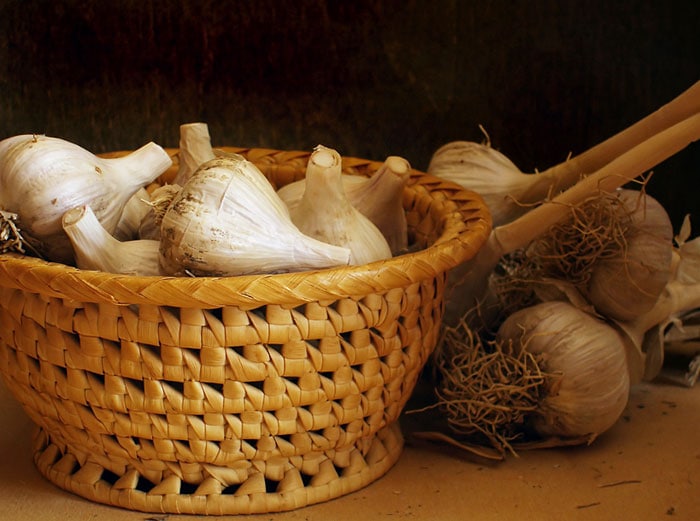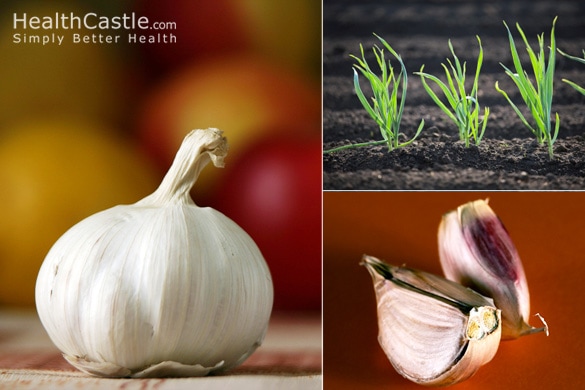
Written By: Christina Newberry
Reviewed By: Gloria Tsang, RD
Title: Registered Dietitian
Last Updated on:

Midsummer is garlic harvesting time. Harvesting crops like garlic and onions that grow underground can require a little bit of guesswork, because unlike fruits and vegetables that grow above ground, you can’t just give them a squeeze to see if they are ready to go. In fact, you can’t even see what’s been developing underground all season. So, how do you know when your homegrown garlic is ready to harvest and store?


Garlic should usually be ready to harvest sometime in July or August, depending on when you planted and what the weather is like in a particular year. If possible, keep the growing plants fairly dry for the last few weeks before harvest so they have a chance to start drying out in the ground. This will make them easier to lift and easier to “cure,” or prepare for storage.
The best way to tell when your garlic is ready to harvest is to watch the leaves. When the bottom leaves start to turn brown and wither, it’s time to start thinking about harvesting your garlic. Start by pulling up just one plant to see what kind of shape its in. The bulb should be well formed with good-sized cloves that have filled out the bulb to that familiar garlic shape. If your first bulb looks too small or underdeveloped, give the other plants a little while longer before you pull them. Otherwise, go ahead and harvest the whole crop!
It might be tempting to try to pull the whole plant up by the leaves, but don’t do it! You risk seriously damaging the bulb and ruining your garlic harvest. Likewise, don’t use a big shovel or anything else that could slice through your garlic bulbs. If you slice through a bulb, you will have to use it right away, as it will not cure properly for storage.
The best method is to use a garden fork or hand trowel to dig very gently around the plant until you have loosened the bulb. Then, lift the bulb by hand. You can brush off any excess soil, but be careful not to remove the skin that protects the cloves.
Move the garlic into the shade, where it will stay for a few weeks as you get it ready for storage.
The first stage before you can put your garlic away for storage is the curing process mentioned above. Curing basically means allowing time for the greens of the plant to die back fully and for the bulb’s skin to dry out and form a protective layer around the cloves. Essentially, this is the time required for the garlic to change from a growing plant to a hardy bulb that you can store for months.
Once you’ve brushed the soil off your garlic and moved it into the shade, ensure it’s in an area with good air circulation (you can hang it or place it on a screen if you have the space) and keep it absolutely dry. Once the leaves and roots have all turned completely brown and withered, you can cut them off. If you are planning to store your garlic in a garlic braid, leave stems long enough for braiding.
After about two weeks, the garlic can go into storage. You can hang braided garlic in your kitchen, or keep the bulbs in a mesh bag in your cupboard or pantry. Don’t put them in the fridge or store them anywhere that gets direct sunlight.
You may have missed it this year, but if you’re a garlic fan, be sure to keep an eye out for this bonus garlic harvest that happens about a month before the bulbs are ready to go. Each garlic plant will send up a central shoot with a teardrop-shaped bud on the end. This is the scape – and you can eat it! Garlic scapes have a mild garlic flavor and can be used in stir-fries, sauteed, or added to other dishes. You should cut the scape once its stem has formed a loop. Even if you don’t want to eat the scape, you should cut it off – otherwise the plant puts its energy into producing a flower instead of growing the bulb.
Garlic is an easy plant to grow – just put the cloves in the ground in late fall or early spring and your job is pretty much done until the scape appears. Since more than half the garlic sold in the United States comes from China, growing your own is one easy way to eat much more local and reap its heart health benefits.
Alumni: University of Victoria – Christina Newberry is a writer and editor whose work has appeared in national and local magazines and newspapers. With a Bachelor’s degree in English and Anthropology from the University of Victoria and a Journalism Certificate from Langara College, Christina brings keen curiosity and the love of a good story to her work with HealthCastle.com.
Christina is a passionate traveler and urban gardener with an interest in vegetarian eating and making good, tasty food from scratch. Sharing lessons learned from her own experiences, Christina writes about lifestyle topics for HealthCastle, with a focus on eating well at home and on the road.